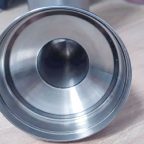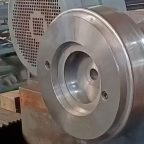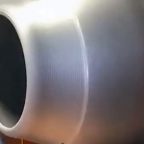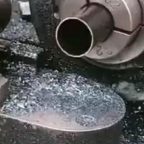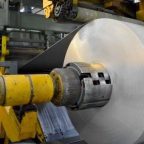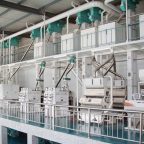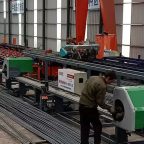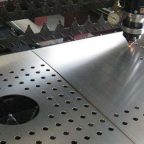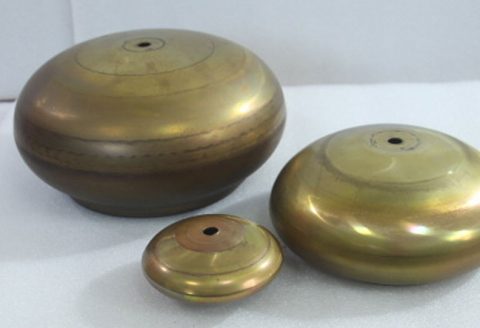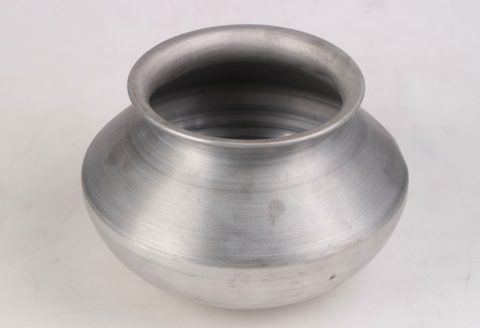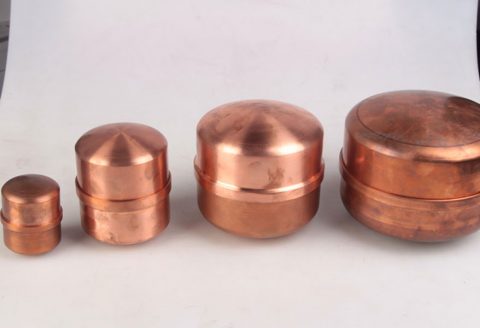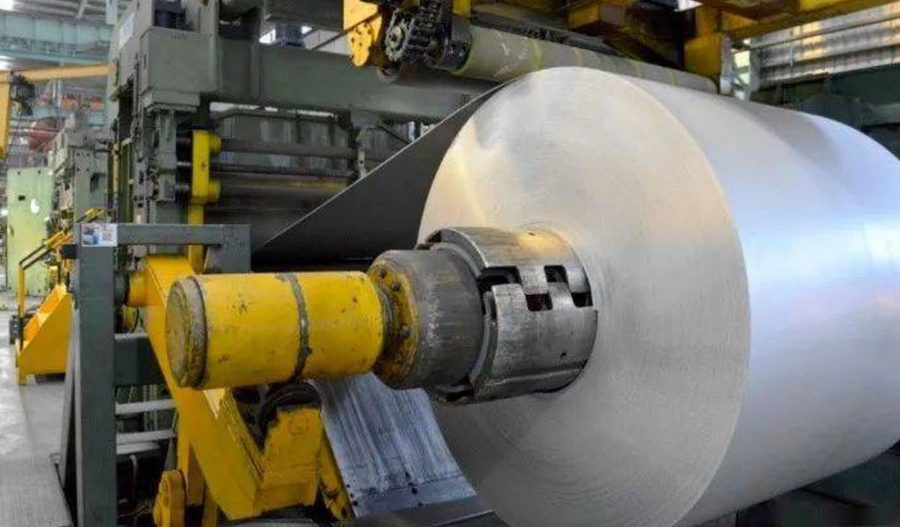
Nanocrystalline (NC) and ultrafine-grained (UFG) metal materials, characterized by grain sizes typically below 100 nm and between 100 nm and 1 μm, respectively, have garnered significant attention in materials science due to their exceptional mechanical properties, including high strength, enhanced hardness, and, in some cases, improved ductility. These properties arise from their unique microstructures, which feature a high density of grain boundaries (GBs) and other lattice defects that profoundly influence deformation behavior. Large spinning deformation, a severe plastic deformation (SPD) technique, is a powerful method for processing bulk metallic materials to achieve NC and UFG microstructures. This article comprehensively explores the microstructure refinement mechanisms and plastic strengthening behavior of NC and UFG metals during large spinning deformation, emphasizing the interplay of deformation mechanisms, microstructural evolution, and mechanical property enhancements. The discussion is supported by detailed tables comparing key parameters across various metals and processing conditions, providing a rigorous scientific foundation for understanding these phenomena.
Large spinning deformation involves subjecting a metal workpiece to high shear strains under compressive forces, typically through rotational contact with a tool, resulting in significant grain refinement and defect accumulation. Unlike other SPD techniques, such as equal-channel angular pressing (ECAP) or high-pressure torsion (HPT), spinning deformation is particularly suited for producing components with complex geometries, such as thin-walled tubes or conical parts, making it industrially relevant. The process induces extreme plastic strains, often exceeding true strains of 4–6, which drive dynamic recrystallization, dislocation interactions, and phase transformations, ultimately yielding refined microstructures. This article delves into the fundamental mechanisms governing grain refinement, the role of grain boundaries and defects in plastic strengthening, and the influence of processing parameters, material composition, and deformation conditions on the resulting properties.
Fundamentals of Nanocrystalline and Ultrafine-Grained Metals
Definition and Characteristics
Nanocrystalline metals are polycrystalline materials with average grain sizes below 100 nm, while UFG metals have grain sizes ranging from 100 nm to 1 μm. These materials exhibit a high volume fraction of grain boundaries, which constitute up to 50% of the material volume in NC metals with grain sizes around 10 nm. The grain boundaries in NC and UFG metals are often in a non-equilibrium state, characterized by high dislocation densities, excess free volume, and long-range stress fields. These features distinguish NC and UFG metals from their coarse-grained (CG) counterparts, which typically have grain sizes exceeding 10 μm.
The mechanical properties of NC and UFG metals are governed by the Hall-Petch relationship, which posits that yield strength (σ_y) increases inversely with the square root of grain size (d):
[ \sigma_y = \sigma_0 + k d^{-1/2} ]
where σ_0 is the lattice friction stress, and k is a material-specific constant. This relationship holds for grain sizes down to approximately 20–30 nm, below which inverse Hall-Petch behavior may occur due to grain boundary sliding (GBS) dominating deformation. NC and UFG metals also exhibit reduced strain hardening, high strain rate sensitivity, and susceptibility to shear localization, which influence their plastic strengthening behavior during large spinning deformation.
Synthesis via Severe Plastic Deformation
Severe plastic deformation techniques, including ECAP, HPT, accumulative roll-bonding (ARB), and large spinning deformation, are top-down approaches for producing NC and UFG metals. These methods impose high strains (ε > 2) under high hydrostatic pressure, preventing crack formation and enabling significant grain refinement. Large spinning deformation, in particular, combines shear and compressive stresses to refine grains to the nanoscale or submicron scale, often achieving grain sizes as small as 20–50 nm in metals like copper, aluminum, and titanium alloys.
The spinning process involves a workpiece rotating at high speed while a tool applies localized pressure, inducing shear strains that accumulate with each pass. The equivalent strain (ε_eq) in spinning can be approximated as:
[ \varepsilon_{eq} = \frac{2}{\sqrt{3}} \ln \left( \frac{t_0}{t_f} \right) + \gamma ]
where t_0 and t_f are the initial and final thicknesses of the workpiece, and γ represents the shear strain component. Strains in spinning can reach values of 4–8, comparable to HPT, making it an effective method for microstructure refinement.
Microstructure Refinement Mechanisms in Large Spinning Deformation
Dynamic Recrystallization
Dynamic recrystallization (DRX) is a primary mechanism for grain refinement during large spinning deformation. DRX occurs when high plastic strains generate sufficient dislocation density to trigger the nucleation of new, strain-free grains. In NC and UFG metals, DRX is often continuous (cDRX), involving the progressive transformation of dislocation substructures into high-angle grain boundaries (HAGBs). The process can be described as follows:
- Dislocation Accumulation: Initial deformation introduces dislocations, which form low-angle grain boundaries (LAGBs) and subgrains.
- Subgrain Rotation: Continued straining causes subgrains to rotate, increasing misorientation and converting LAGBs to HAGBs.
- Grain Nucleation: New grains form at triple junctions or high-stress regions, leading to a refined microstructure.
The critical strain for DRX depends on the material’s stacking fault energy (SFE). Low-SFE metals (e.g., copper, stainless steel) exhibit pronounced DRX due to restricted dislocation mobility, while high-SFE metals (e.g., aluminum) require higher strains for refinement. For example, copper processed by spinning at room temperature can achieve grain sizes of 50–100 nm after strains of ε ≈ 4, driven by cDRX.
Dislocation Interactions and Substructure Formation
Dislocation interactions play a critical role in microstructure refinement. During spinning, dislocations are generated, annihilated, and reorganized into substructures, such as dislocation cells, walls, and tangles. The dislocation density (ρ) in NC and UFG metals can reach 10^15–10^16 m^-2, significantly higher than in CG metals (10^12–10^14 m^-2). The Bailey-Hirsch relationship describes the contribution of dislocation density to yield strength:
[ \sigma_d = \alpha M G b \rho^{1/2} ]
where α is a constant (~0.3–0.5), M is the Taylor factor (~3 for polycrystals), G is the shear modulus, and b is the Burgers vector. In spinning, high shear strains promote dislocation entanglement, leading to the formation of subgrains with sizes of 50–200 nm, which further evolve into equiaxed grains via DRX.
Deformation Twinning
In low-SFE metals and alloys, deformation twinning is a significant refinement mechanism. Twins form when partial dislocations nucleate and propagate, creating twin boundaries that subdivide grains. During spinning, high strain rates and shear stresses favor twinning in materials like NC copper and austenitic stainless steels. Twin boundaries act as barriers to dislocation motion, enhancing strength while maintaining ductility. The twin thickness in NC copper processed by spinning can be as small as 10–20 nm, contributing to grain refinement and plastic strengthening.
Grain Boundary Sliding and Rotation
At grain sizes below 30 nm, GBS becomes a dominant deformation mechanism, particularly at elevated temperatures or high strain rates. In spinning, GBS facilitates grain refinement by allowing grains to slide past each other, reducing dislocation pile-ups and promoting grain rotation. Grain rotation aligns grains into favorable orientations, further refining the microstructure. GBS is described by the following constitutive equation:
[ \dot{\varepsilon} = A \frac{D_{gb} G b}{k T} \left( \frac{b}{d} \right)^p \left( \frac{\sigma}{G} \right)^n ]
where (\dot{\varepsilon}) is the strain rate, D_gb is the grain boundary diffusion coefficient, k is Boltzmann’s constant, T is temperature, p is the grain size exponent (~2–3), and n is the stress exponent (~2). GBS contributes to superplastic behavior in UFG metals at moderate temperatures, enhancing formability during spinning.
Role of Second-Phase Particles
Second-phase particles, such as precipitates or dispersoids, influence refinement by pinning grain boundaries and dislocations. In alloys like Al-Mg or Ti-6Al-4V, particles stabilize subgrains, preventing coarsening during DRX. The Zener pinning pressure (P_z) is given by:
[ P_z = \frac{3 f \gamma_{gb}}{r} ]
where f is the volume fraction of particles, γ_gb is the grain boundary energy, and r is the particle radius. During spinning, particles promote the formation of finer grains (20–50 nm) by increasing nucleation sites and restricting grain growth.
Plastic Strengthening Behavior
Hall-Petch Strengthening
The primary strengthening mechanism in NC and UFG metals is Hall-Petch strengthening, driven by grain size reduction. The high density of grain boundaries impedes dislocation motion, increasing yield strength. For example, NC copper with a grain size of 20 nm can achieve a yield strength of 800–1000 MPa, compared to 50–100 MPa for CG copper. However, at grain sizes below 10–20 nm, the inverse Hall-Petch effect may occur, where strength decreases due to GBS dominating over dislocation-mediated plasticity.
Dislocation Strengthening
Dislocation strengthening, as described by the Bailey-Hirsch relationship, contributes significantly to the high strength of NC and UFG metals. The high dislocation density in spun materials enhances hardness and yield strength but reduces ductility due to limited strain hardening. Annealing post-spinning can reduce dislocation density, improving ductility while retaining strength.
Twin Boundary Strengthening
Twin boundaries in NC metals act as effective barriers to dislocation motion, similar to grain boundaries. The strengthening effect of twins is described by a modified Hall-Petch relationship:
[ \sigma_{tw} = \sigma_0 + k_{tw} \lambda^{-1/2} ]
where λ is the twin spacing, and k_tw is a constant. In NC copper processed by spinning, twin boundaries spaced at 10–20 nm can increase yield strength by 200–300 MPa.
Strain Rate Sensitivity and Shear Localization
NC and UFG metals exhibit increased strain rate sensitivity (m), defined as:
[ m = \frac{\partial \ln \sigma}{\partial \ln \dot{\varepsilon}} ]
Values of m in NC metals (0.02–0.1) are higher than in CG metals (0.01–0.02), reflecting the dominance of GBS and dislocation-grain boundary interactions. During spinning, high strain rates (10^–10^3 s^-1) promote shear localization, forming shear bands that influence plastic strengthening. Shear bands in NC iron processed by spinning can reduce ductility but enhance local hardness.
Superplasticity and Ductility
UFG metals processed by spinning often exhibit superplasticity at moderate temperatures (0.4–0.6 T_m, where T_m is the melting point) due to GBS and diffusion-controlled mechanisms. For example, UFG aluminum alloys with grain sizes of 200–500 nm can achieve elongations of 300–500% at 300–400°C. Superplasticity enhances formability, making spinning ideal for producing complex components.
Influence of Material and Processing Parameters
Material Composition
The composition of the metal significantly affects refinement and strengthening. Low-SFE metals (e.g., Cu, Ni, stainless steel) exhibit pronounced twinning and DRX, leading to finer grains and higher strength. High-SFE metals (e.g., Al, Fe) rely on dislocation interactions and cDRX, resulting in slightly larger grains (100–300 nm). Alloying elements, such as Mg in Al or V in Ti, enhance grain refinement by forming precipitates that pin boundaries.
Deformation Temperature
Temperature influences the balance between dislocation generation and annihilation. Room-temperature spinning maximizes dislocation density and refinement but may induce cracking in brittle materials. Elevated temperatures (0.2–0.4 T_m) promote DRX and GBS, reducing grain size but potentially causing coarsening. For example, Ti-6Al-4V spun at 600°C achieves a grain size of 50–100 nm, compared to 200–300 nm at 800°C.
Strain Rate
High strain rates in spinning (10^–10^3 s^-1) favor dislocation accumulation and twinning, enhancing refinement. Low strain rates allow for diffusion and recovery, reducing dislocation density and increasing grain size. NC copper spun at 10^2 s^-1 exhibits a grain size of 20–50 nm, while at 10^–1 s^-1, grains grow to 100–150 nm.
Number of Passes
Multiple spinning passes increase cumulative strain, further refining grains. For aluminum, one pass (ε ≈ 2) reduces grain size from 20 μm to 1 μm, while four passes (ε ≈ 8) yield grains of 100–200 nm. However, beyond a critical strain, grain refinement saturates due to a balance between generation and annihilation processes.
Comparative Analysis of NC and UFG Metals
The following tables summarize the microstructure refinement and mechanical properties of NC and UFG metals processed by large spinning deformation, based on recent studies and theoretical models.
Table 1: Microstructure Refinement in NC and UFG Metals via Spinning
| Material | Initial Grain Size (μm) | Final Grain Size (nm) | Strain (ε_eq) | Mechanism | Temperature (°C) | Reference |
|---|---|---|---|---|---|---|
| Copper | 20 | 20–50 | 4–6 | cDRX, Twinning, GBS | 25 | |
| Aluminum | 50 | 100–200 | 3–5 | cDRX, Dislocation Cells | 25 | |
| Ti-6Al-4V | 10 | 50–100 | 5–8 | DRX, Precipitate Pinning | 600 | |
| Stainless Steel | 30 | 30–80 | 4–7 | Twinning, Martensite | 25 | |
| Iron (bcc) | 40 | 50–150 | 3–6 | Shear Bands, cDRX | 25 |
Table 2: Mechanical Properties of NC and UFG Metals Post-Spinning
| Material | Grain Size (nm) | Yield Strength (MPa) | Ultimate Tensile Strength (MPa) | Elongation (%) | Hardness (HV) | Reference |
|---|---|---|---|---|---|---|
| Copper | 20–50 | 800–1000 | 900–1200 | 5–10 | 250–300 | |
| Aluminum | 100–200 | 300–400 | 350–450 | 15–20 | 100–150 | |
| Ti-6Al-4V | 50–100 | 1200–1400 | 1300–1500 | 8–12 | 350–400 | |
| Stainless Steel | 30–80 | 1800–2000 | 1900–2100 | 5–8 | 500–600 | |
| Iron (bcc) | 50–150 | 1000–1200 | 1100–1300 | 3–7 | 300–350 |
Table 3: Effect of Processing Parameters on Grain Size
| Material | Temperature (°C) | Strain Rate (s^-1) | Passes | Final Grain Size (nm) | Notes | Reference |
|---|---|---|---|---|---|---|
| Copper | 25 | 10^2 | 4 | 20–50 | High twinning activity | |
| Copper | 200 | 10^–1 | 2 | 100–150 | GBS dominant, coarsening observed | |
| Aluminum | 25 | 10^1 | 3 | 150–200 | Dislocation cells, no twinning | |
| Ti-6Al-4V | 600 | 10^0 | 5 | 50–100 | Precipitate pinning enhances DRX | |
| Stainless Steel | 25 | 10^2 | 4 | 30–80 | Martensite transformation |
Challenges and Limitations
Ductility and Strain Hardening
NC and UFG metals often exhibit low ductility due to limited strain hardening, resulting from high dislocation annihilation rates at grain boundaries. During spinning, shear localization exacerbates this issue, leading to premature failure. Strategies to enhance ductility include introducing bimodal grain size distributions or annealing post-spinning to reduce dislocation density.
Thermal Stability
The non-equilibrium grain boundaries in NC and UFG metals are prone to coarsening at elevated temperatures, limiting their thermal stability. For example, NC copper with a grain size of 20 nm may coarsen to 100–200 nm at 200°C. Incorporating nanoparticles or alloying elements can enhance stability by pinning boundaries.
Processing Scalability
While spinning is effective for small components, scaling to large-scale production is challenging due to tool wear, non-uniform strain distribution, and energy costs. Advances in tool materials and process optimization are needed to overcome these limitations.
Applications of NC and UFG Metals
NC and UFG metals processed by spinning are used in aerospace, automotive, and biomedical applications due to their high strength-to-weight ratio and formability. Examples include:
- Aerospace: Turbine blades and structural components made from UFG Ti-6Al-4V.
- Automotive: Lightweight UFG aluminum alloys for fuel-efficient vehicles.
- Biomedical: NC stainless steel for implants with enhanced corrosion resistance and strength.
Future Directions
Future research should focus on:
- Hybrid Processing: Combining spinning with other SPD techniques (e.g., ECAP) to achieve finer grains and improved properties.
- Advanced Characterization: Using in-situ techniques like synchrotron X-ray diffraction to study real-time microstructure evolution.
- Computational Modeling: Developing multiscale models to predict refinement and strengthening mechanisms.
- Sustainable Processing: Reducing energy consumption and tool wear in large-scale spinning.
Conclusion
Large spinning deformation is a versatile SPD technique for producing NC and UFG metals with exceptional mechanical properties. Microstructure refinement occurs through dynamic recrystallization, dislocation interactions, twinning, and grain boundary sliding, driven by high shear strains and compressive forces. Plastic strengthening is achieved via Hall-Petch, dislocation, and twin boundary mechanisms, although challenges like low ductility and thermal instability persist. The comparative tables highlight the influence of material, temperature, strain rate, and passes on grain size and properties, providing a comprehensive reference for researchers and engineers. Continued advancements in processing, characterization, and modeling will further unlock the potential of NC and UFG metals in high-performance applications.
Maximize Tooling and CNC Metal Spinning Capabilities.
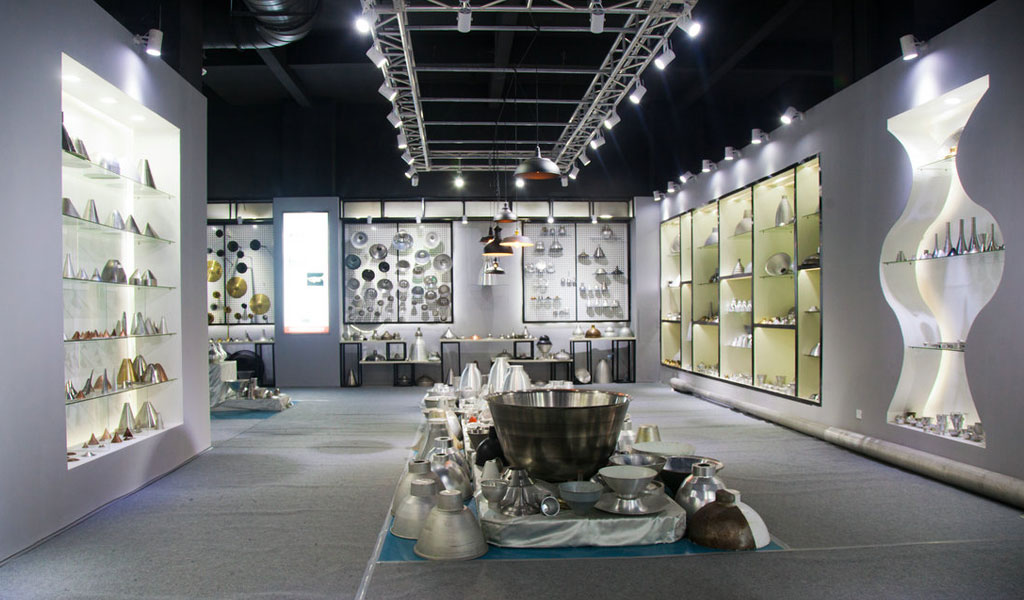
At BE-CU China Metal Spinning company, we make the most of our equipment while monitoring signs of excess wear and stress. In addition, we look into newer, modern equipment and invest in those that can support or increase our manufacturing capabilities. Our team is very mindful of our machines and tools, so we also routinely maintain them to ensure they don’t negatively impact your part’s quality and productivity.
Talk to us today about making a rapid prototype with our CNC metal spinning service. Get a direct quote by chatting with us here or request a free project review.
BE-CU China CNC Metal Spinning service include : CNC Metal Spinning,Metal Spinning Die,Laser Cutting, Tank Heads Spinning,Metal Hemispheres Spinning,Metal Cones Spinning,Metal Dish-Shaped Spinning,Metal Trumpet Spinning,Metal Venturi Spinning,Aluminum Spinning Products,Stainless Steel Spinning Products,Copper Spinning Products,Brass Spinning Products,Steel Spinning Product,Metal Spinnin LED Reflector,Metal Spinning Pressure Vessel,
